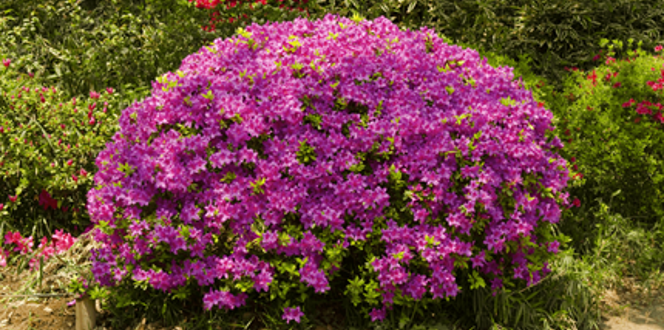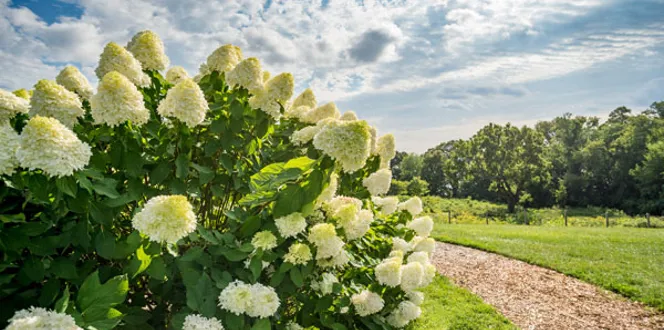Is there really anything better than perennials in your garden?
They deliver brilliant blooms and amazing texture year after year. They encourage pollinators and are particularly striking when planted in groups in your landscape beds.
The trickiest part of perennial gardening is understanding the different bloom times of these plants. The goal in your landscape is to have something blooming from spring through fall, and even add some winter interest. But understanding how you can plant perennials in a way that creates this effect can be pretty confusing.
If you love gardening with perennials in the Northeast and Midwest but aren’t sure about which perennials are in bloom month by month, we’ve got you covered with this guide to all-season color with perennials:
Early Perennial Bloomers (March And April)
After a cold, long winter, you long for some greenery and color to brighten your garden and bring you out of that icy funk.
Combine any of these early blooming perennials with bulbs for a great spring awakening.
Helleborus
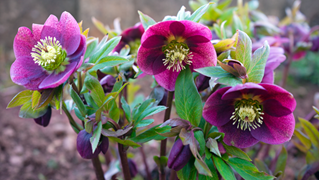
- Light: This is a great plant for your shade garden, forming low mounds of dark, evergreen foliage that boast large flowers that can range from pink to purple to ivory to gold to maroon – all with bits of freckles and spots.
- Water: This plant grows best in well-drained soil that receives 1 inch of water weekly, especially during the first year of planting.
- Grow Zone: Expect spring through summer-blooming from this shade in USDA zones 5 to 9.
Iberis
- Light: Boasting white or pink showy blooms against dark green foliage in full sun.
- Water: This perennial is moderately drought tolerant and likes well-drained soil.
- Grow Zone: This ground-hugging perennial is a late bloomer that is known to brighten bed edges in USDA zones 4 to 8.
Primula
- Light: These flowers thrive in partial shade under trees. If you plant them in full sun, they’ll need more water. Some species do best with a little morning sun, while others would rather have full shade.
- Water: These perennials are thirsty, requiring consistent soil moisture, but not soggy soil.
- Grow Zone: This ground-hugging perennial is a late bloomer that is known to brighten bed edges in USDA zones 4 to 8.
Phlox
- Light: Phlox is a sun-loving perennial with large, long-lasting flower clusters.
- Water: Water phlox weekly for the first couple weeks and keep the soil lightly moist afterward.
- Grow Zone: This native American wildflower thrives in USDA zones 4 to 8.
Creeping Phlox
- Light: This perennial adds a colorful, spring, pastel-toned carpet of small, star-shaped blooms in full sun to partial shade.
- Water: Fairly low maintenance, creeping phlox only needs watering if you have a week or two without rain.
- Grow Zone: Plant in USDA zones 3 to 9.
May Perennial Bloomers
Your garden truly awakens in May when any frost fears are past and April showers begin to diminish. Try some of these reliable early blooming perennials.
Trillium
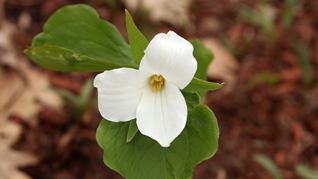
- Light: These native woodland plants bring symmetry in shady areas with three-petaled flowers.
- Water: Fairly low maintenance, water trillium to prevent them from drying out.
- Grow Zone: Trillium species vary in hardness in USDA zones 4 to 9.
Dianthus
- Light: Handsome blue-gray foliage with jagged-edged flowers in white, pink, lilac, or red thrive in full sun, but they don’t love the high heat of mid-summer.
- Water: These perennials require weekly watering.
- Grow Zone: Plant in neutral to acidic soil in USDA zones 3 to 9.
Spiderwort
- Light: While this perennial prefers partial shade, it can do well in most landscape beds as long as it gets at least a couple hours of light daily.
- Water: Spiderwort likes moist soil; water every few days during hotter months.
- Grow Zone: These blue-purple blooms decorate gardens in USDA zones 4 to 7.
Allium
- Light: For the best flowers, plant in full sun.
- Water: Alliums need infrequent watering, especially if it rains fairly regularly. Every 3 to 5 days is sufficient if rain is light.
- Grow Zone: These fast-growing, ornamental onions have round flower heads made up of dozens of star-shaped blooms. Plant in USDA zones 4 to 10.
Astilbe
- Light: One of the easiest early-blooming perennials to grow, astilbes have long-blooming, plume-like flower heads that come in white, pink, and red and grow on tall, airy stalks. They light up any shade garden.
- Water: These perennials don’t handle drought well; don’t leave them dry too long.
- Grow Zone: These plants perform well in USDA zones 3 to 8.
Peonies
- Light: Giant, long-lasting blooms in yellow, pink, red, or white on strong stems prefer full to partial sun.
- Water: Water in spring as new growth emerges and then water lightly twice a week.
- Grow Zone: Peonies are hardy in USDA zones 3 to 8.
Dicentra/Lamprocapnos
- Light: Also known as bleeding hearts, this perennial likes partial shade or shady gardens.
- Water: Plant in well-drained soil that receives consistent moisture.
- Grow Zone: Plant in USDA zones 3 to 9.
June Perennial Bloomers
When it’s finally consistently warm, these summer-blooming perennials can be stars in your garden.
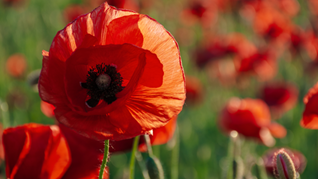
Poppy
- Light: Thin, bright blossoms add warmth to full sun garden spaces.
- Water: Plant in well-drained soil that is well watered.
- Grow Zone: Plant in USDA zones 3 to 8, depending on species.
Coreopsis
- Light: Plant these long-blooming, drought-tolerant blooms in full sun to partial shade.
- Water: Water thoroughly at least once weekly.
- Grow Zone: Plant in USDA zones 2 to 11.
Columbine
- Light: In full sun, this perennial’s flowers come in a variety of colors, ranging from pink to purple to red to orange to yellow and even white with contrasting centers.
- Water: Maintain average to moist, well-drained soil.
- Grow Zone: Plant this perennial, also known as aquilegia, in USDA zones 3 to 9.
Yarrow
- Light: Popular with pollinators, this sun-loving perennial is great for borders, groundcovers and open areas with showy flower heads made up of tiny blooms on fern-like foliage.
- Water: Give this plant 1 inch of water weekly when new. Once established, it’s drought-tolerant.
- Grow Zone: Plant in USDA zones 3 to 9 where it’s known to attract butterflies.
Daylily
- Light: These clusters of long-stalked, sun-loving, bell-shaped flowers range in color from yellow to red to white.
- Water: Water once or twice weekly.
- Grow Zone: Plant in USDA zones 4 to 9.
Iris
- Light: These flowers have six attractive and colorful lobes – 3 inner and 3 outer – and delight full-sun gardens with vibrant blue-purple blooms with bits of yellow.
- Water: Deeply water every 3 to 4 weeks, depending on the temperature.
- Grow Zone: Plant in USDA zones 3 to 10 in the drier summers in the West and 3 to 8 in the rainier summers in the East.
July & August Perennial Bloomers
We’re in the heat of summer now. These summer-blooming perennials and perennials that bloom in August are special because not only can they thrive in the heat, but they also draw a wide variety of pollinators to your garden.
Salvia

- Light: This perennial, also known as sage, has woody stems, grayish leaves and blue to purple blooms. It prefers full sun.
- Water: Salvia provides well-drained soil. Give them 1 inch of water every 7 to 10 days. Avoid overwatering to prevent root rot.
- Grow Zone: These 18- to 36-inch tall perennials grow best in USDA zones 4 to 10.
Veronica
- Light: Plant in full sun to partial shade for carefree flower spikes in blue, purple, pink, or white.
- Water: Water if summer rainfall is less than 1 inch weekly.
- Grow Zone: Plant in USDA zones 4 to 8.
Monarda
- Light: This bee-loving perennial grows best in full sun or partial shade.
- Water: Open, daisy-like flowers come in shades or red, magenta, lavender, yellow, or white, and need water every 7 to 10 days during dry periods.
- Grow Zone: Plant this perennial, also known as bee balm, in USDA zones 4 to 9.
Asclepias
- Light: These dense, round flower clusters have purplish-pink petals and a white central crown. Plant them in full sun for a show.
- Water: Also known as milkweed, this perennial does not need water except in the driest conditions.
- Grow Zone: Plant in USDA zones 3 to 9.
Echinacea
- Light: These large, showy, summer-blooming perennials are daisy-like but with lavender-pink petals and deep orange centers. Plant in full sun.
- Water: Growing 3 to 4 feet, water 1 inch weekly.
- Grow Zone: Plant in USDA zones 4 to 9.
Hypericum
- Light: These 5-petaled, bright yellow flowers grow best in partial shade.
- Water: Provide 1 inch of water weekly.
- Grow Zone: Plant this perennial, also known as St. Johns Wort, in USDA zones 5 to 9.
Acanthus
- Light: Showy, white or purple flowers with leaves just as attractive are great additions to shade or partial shade beds.
- Water: Thrives in a wide range of soils; avoid poorly-drained areas. While this perennial doesn’t need frequent watering, it will wilt if it dries out.
- Grow Zone: Plant this perennial in USDA zones 5 to 10.
Crocosmia
- Light: These deep orange, tube-shaped blooms erupt in clusters to provide flower spikes in full sun.
- Water: Water once weekly to keep soil evenly moist.
- Grow Zone: Plant this perennial in USDA zones 6 to 9.
Hibiscus
- Light: Large, trumpet-shaped blooms brighten gardens in colors of white, pink, red, blue, orange, yellow, and purple. Give them 6 to 8 hours of sun daily.
- Water: Maintain moist, not soggy, soil. This equates to about twice a week when there is no rain.
- Grow Zone: Plant this perennial in USDA zones 5 to 11.
Lobelia
- Light: This late-blooming perennial has blue flowers that reach heights of 2 to 3 feet in full sun locations.
- Water: Belonging to the bellflower family, these flowers require watering deeply. Allow the top 1 to 2 inches of soil to dry before watering again.
- Grow Zone: Plant in USDA zones 4 to 8.
Ligularia
- Light: This perennial thrives in areas along ponds in partial shade.
- Water: Water deeply weekly or as necessary in hot weather.
- Grow Zone: Plant these yellow or orange blooms on glossy green foliage in USDA zones 4 to 8.
Gaura
- Light: Your garden will shine with white and pink flowers in full sun and some afternoon shade.
- Water: Provide 1 inch of water only when soil is dry. Don’t overwater.
- Grow Zone: Plant this perennial in USDA zones 5 to 9.
Geranium
- Light: This perennial comes in a broad array of colors and textures and prefers partial sun locations.
- Water: Provide adequate drainage, but avoid oversaturation.
- Grow Zone: Geranium is an attractive plant all season in USDA zones 3 to 8.
Black-Eyed Susan
- Light: These yellow beaties with dark centers grow best with at least 6 to 8 hours of sunlight daily.
- Water: While moderately drought-tolerant, don’t let the soil dry out entirely. Water when the top of the soil feels dry.
- Grow Zone: Plant in USDA zones 3 to 9.
Russian Sage
- Light: For the best effect, plant in full sun. This late-blooming perennial will reward you with clouds of blue flowers.
- Water: This perennial prefers tocky, alkaline soils and thrives in drier soils.
- Grow Zone: Plant in USDA zones 5 to 9.
September Perennial Bloomers
As gardens are losing most of their color, you can rely on these late-blooming perennials to help extend your garden show.
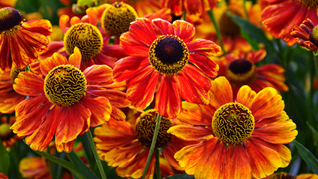
Helenium
- Light: Yellow, daisy-like flower heads thrive in full sun.
- Water: Water during dry periods.
- Grow Zone: Plant in USDA zones 3 to 8.
Sedum
- Light: These hardy groundcovers offer a rainbow of foliage shades mixed with bright flowers that can bloom through October in full sun locations.
- Water: Give these highly adaptable flowers well-drained soils. Ensure they aren’t overwatered.
- Grow Zone: Plant in USDA zones 3 to 11.
Anemone
- Light: Lobed petals on double flowers resemble oversized mums and grow best in part sun to full sun.
- Water: Water regularly when rain is lacking.
- Grow Zone: Plant in USDA zones 3 to 7.
Chelone
- Light: Pink, white, and purple flowers grace your garden in partial sun.
- Water: Keep soil consistently moist for these flowers to perform well.
- Grow Zone: Plant in USDA zones 5 to 9.
Eupatorium
- Light: This upright perennial has attractive, heart-shaped leaves and small white flower clusters, thriving in partial sun to light shade.
- Water: Enjoys regular, deep watering.
- Grow Zone: Plant in USDA zones 5 to 9.
Plumbago
- Light: For the best blooms, plant in full sun. You’ll be rewarded with phlox-like flowers, deer resistance and easy-growing late-blooming perennial color.
- Water: Water once weekly once established.
- Grow Zone: Plant in USDA zones 8 to 11.
All Season Perennial Bloomers
As certain perennials go in and out of bloom, some of these flowers don’t stick by a short perennial bloom time chart. They deliver color for a little bit longer than just one season.
Shasta Daisy

- Light: These all-white daisy petals with yellow disk florets and contrasting dark green leaves grow best in full sun or partial shade.
- Water: These tough flowers are drought-tolerant and don’t like soggy soils. Only water 1 inch weekly if soil is dry.
- Grow Zone: Enjoy blooms from early summer to fall that stand 12 to 24 inches tall in USDA zones 4 to 9.
FOLLOW THESE TIPS ON HOW TO SELECT, ARRANGE, AND PLANT FLOWERS IN YOUR GARDEN.


